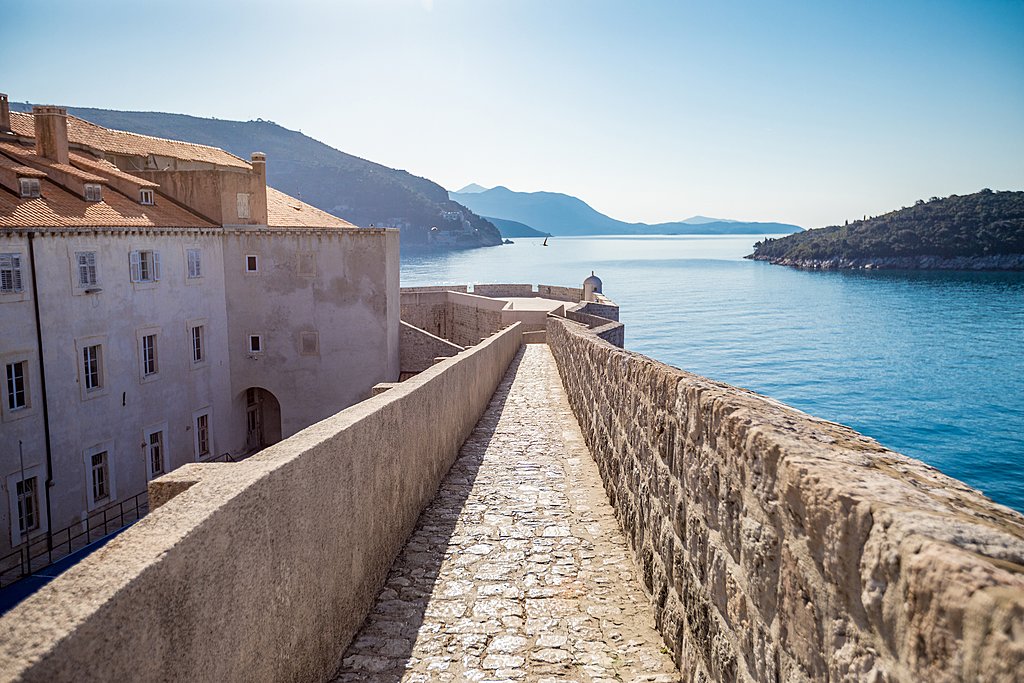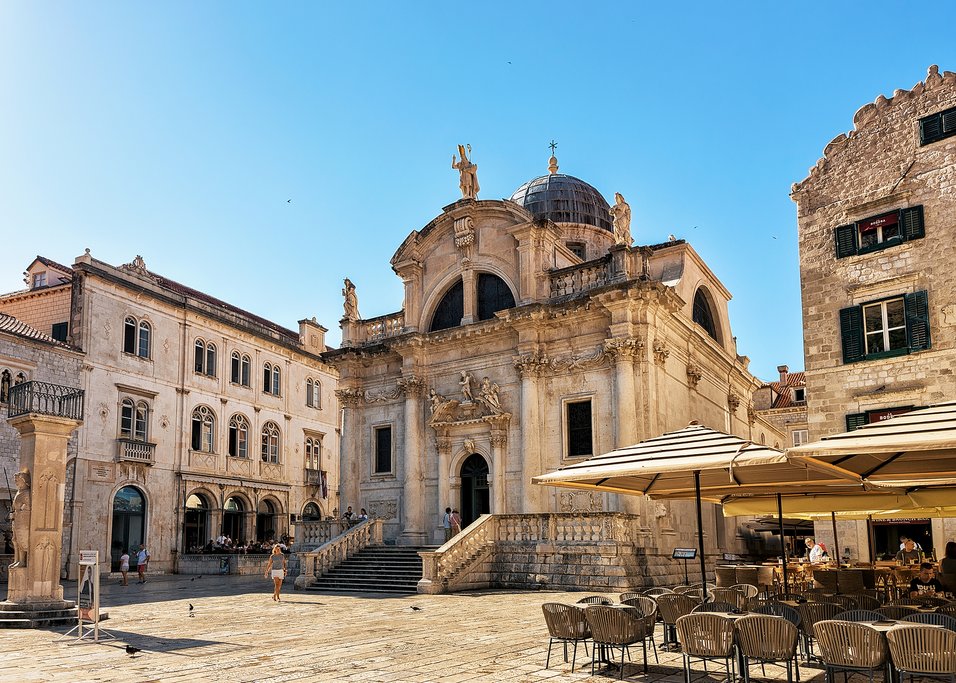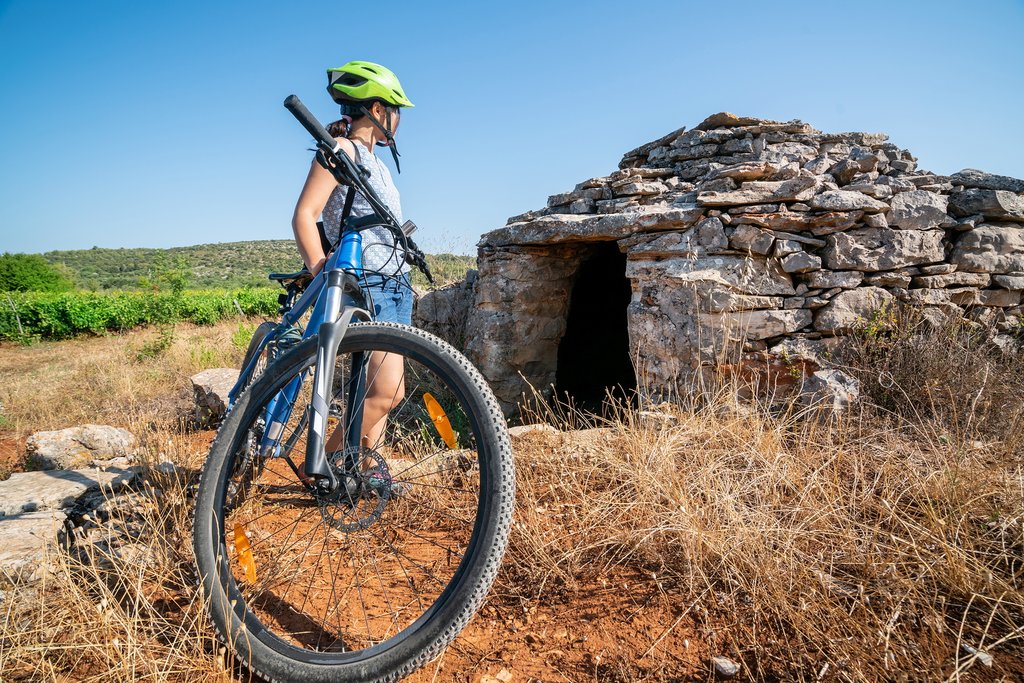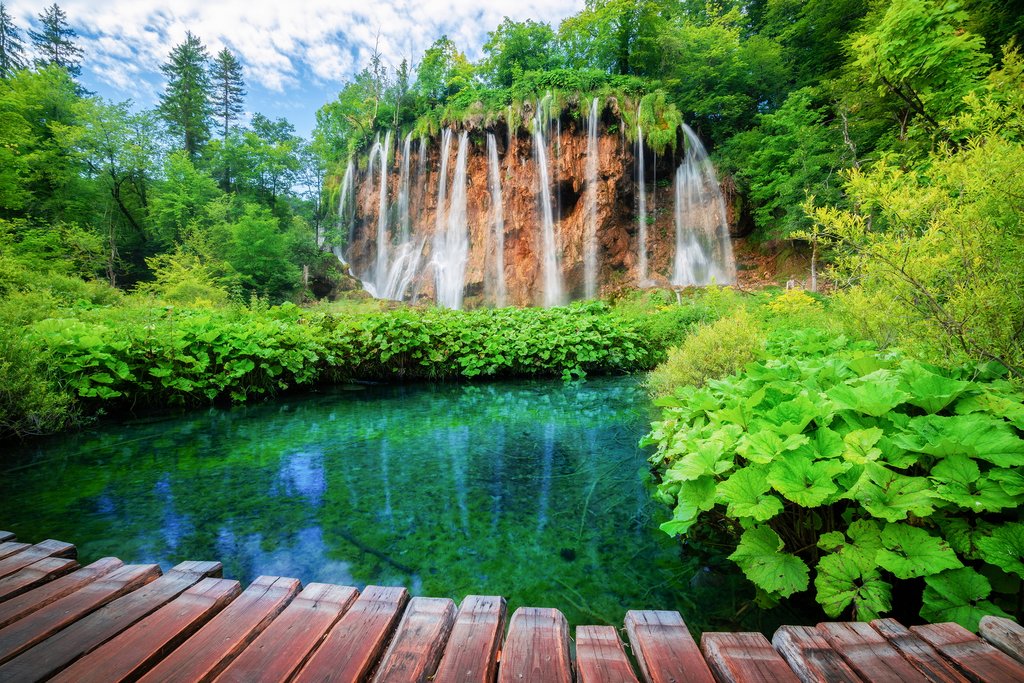Highlights
- Paddle the open sea from Dubrovnik's Banje Beach to Lokrum Island
- Climb Ston's historic defense wall for views of glittering saltpans and the Adriatic
- Cycle through olive groves and vineyards and past coastal villages on Hvar
- Swim, rappel, and cliff jump your way down the Cetina River
- Trek under dramatic limestone cliffs in striking Paklenica National Park
Brief Itinerary
| Day | Highlights | Overnight |
|---|---|---|
| Day 1 | Welcome to Dubrovnik! | Dubrovnik |
| Day 2 | Walking Tour of Dubrovnik, Sea Kayaking around Lokrum Island | Dubrovnik |
| Day 3 | Dubrovnik to Korčula via Pelješac Peninsula | Korčula Town |
| Day 4 | Hike through the Forests and Vineyards of Korčula | Korčula Town |
| Day 5 | Ferry from Korčula to Hvar | Hvar Town |
| Day 6 | Cycle Tour around Hvar Island | Hvar Town |
| Day 7 | Ferry from Hvar to Split | Split |
| Day 8 | Rafting, Zip-lining, & Canyoning on Cetina River (Day Trip) | Split |
| Day 9 | Split to Zadar, Stopping for a Visit in Šibenik | Zadar |
| Day 10 | Zadar to Plitvice Lakes, Stopping at Paklenica National Park | Plitvice Lakes National Park |
| Day 11 | Sunrise at Plitvice Lakes, Drive to Zagreb | Zagreb |
| Day 12 | Explore Zagreb, Croatia's Bustling Capital | Zagreb |
| Day 13 | Depart Zagreb |
Detailed Itinerary
Day 1: Welcome to Dubrovnik!

This is a treat because you'll be arriving in one of the most ancient fortress cities in Europe. Known as the "Adriatic Pearl," Dubrovnik is a piece of history. While there's evidence of settlements as far back as the Byzantine era, this area only came into its own in the 12th and 13th centuries when it was under the rule of the Venetians. Throughout the middle ages, it was a fortress port encircled by stone walls and filled with baroque churches and renaissance/gothic palaces that still stand today.
Upon arrival at the airport, you'll transfer to your hotel for check-in. Despite being tired from the journey, you'll likely want to get out and explore. Can't-miss activities include riding the cable car up to Srđ Mountain to take in the sunset over the nearby Elafiti Islands, visiting Lovrijenac and Bokar fortresses, and walking along the smooth, limestone-paved streets of historic Old Town.
After spending some time getting to know the city, duck into one of Dubrovnik's many wine bars to relax. It's a good plan, as there's no better manner in which to celebrate your first day in Croatia than by enjoying a glass of white or red wine as the sun goes down over Dubrovnik's Old Town. For dinner, there are a number of great restaurants you can choose from.
Day 2: Walking Tour of Dubrovnik, Sea Kayaking around Lokrum Island

Start your day early (around 8 am) to avoid the crowds and to embark on a tour of Dubrovnik where you'll meet your expert guide outside the entrance to the medieval city at the 16th-century Pile Gate. Entering Old Town, you'll uncover centuries of the city's rich history as you listen to stories of local life and legends and of the importance Dubrovnik once held in the era of the Republic. Highlights include Onofrio's Fountain, the 15th century Rector's Palace, Luza Square, the Church of St. Blaise (St. Vlaho), and the café-lined streets of Brsalje Street.
After touring the streets and alleys, you'll head for Lovrijenac Fortress as well as the city's impressive defensive walls, the second-largest set of city walls in the world. At certain places the wall rises 75 feet high, offering excellent vantage points for photos of the coastline.
In the afternoon, head to the water for a guided kayaking adventure around the city and Lokrum Island—the closest island to Dubrovnik. Starting from Banje Beach, you will paddle to Lokrum Island where you can enjoy a swim in the saltwater lake named the Dead Sea, explore the 15th-century Benedictine monastery, and trek along the car-less trails through overgrown gardens. This is a great way to experience the cultural and historical sites of Dubrovnik from a unique perspective.
Day 3: Dubrovnik to Korčula via Pelješac Peninsula

Today you'll leave Dubrovnik behind and transfer about an hour northwest to the Pelješac Peninsula as you make your way to Korčula. En route, stop in the medieval city of Ston to explore one of the longest defensive stone walls in Europe (originally built to keep predators away from the town's saltpans) and discover the importance this area held in the 14th century. Enjoy beautiful views over Ston and its glittering saltpans from a parapet walkway on Ston's 3,937-foot (1,200 m) wall.
Reward your efforts with a light meal of Ston's famous fresh oysters or mussels accompanied by a glass of local Dingač red wine. Should you choose, you can take a tour of one of the area's family-run wineries for a further sampling of Dingač's famous reds.
When you're ready, continue your journey to Orebić to catch the ferry to Korčula. Once on the island, the afternoon is yours to discover Korčula's numerous restaurants, taverns, shops, and bars as you roam the maze of gray stone houses, alleys, churches, and squares. Check into your hotel in Old Town before heading out to explore, either on foot or perhaps on a rented bicycle, traveling from the town center to one of the secluded beaches on the island.
Driving time (Ston to Orebić): 1 hour
Ferry time (Orebić to Korčula): 20 minutes
Day 4: Hike through the Forests and Vineyards of Korčula

Today, you'll explore Korčula by foot and hike through a nature park full of amazing karst rock formations, dense forest, and wildlife. The walk is peaceful and leisurely and will take you to the ancient Napoleon path along olive groves, small vineyards, and beautiful fields of sage, oregano, and other local herbs. End your hike in the village of Pupnat where a traditional local lunch has been prepared with ingredients from the fields you've just walked through.
After lunch, make your way back to medieval Korčula Town to explore the cobblestone streets, whitewashed buildings, and Gothic and Renaissance architectural masterpieces. Or spend the rest of the day enjoying the beach and water, paddleboarding, swimming, or relaxing on the sand.
Hiking distance: 7-14 miles (11-23 km)
Day 5: Ferry from Korčula to Hvar

Catch the ferry from Korčula to Hvar in the morning (1.5 hours) and check into your hotel. Another Croatian island in the Adriatic Sea, Hvar is a popular destination with tourists due to its natural setting, mild climate, and its historic town of the same name. You'll have the late morning to explore Hvar Town. Visit St. Stephen's Cathedral and climb the steps to the terrace outside of the historic Arsenal to enjoy views over the harbor and the surrounding area.
Depending on interests, you may like to consider renting a scooter to drive through olive groves, lavender fields, and vineyards along the coastline. Bring a bottle of wine and watch the sunset from Španjola Fortress. The short walk up to this old 16th-century fortress is worth the hike for the stunning views of Hvar Town and the Pakleni islands. Alternatively, embark on a hike from Hvar town to Velo Grablje and Malo Grablje or go on an idyllic sunset kayaking tour of the nearby Pakleni archipelago.
Chat with a local specialist who can help organize your trip.
Day 6: Cycle Tour around Hvar Island

Start the morning with a little self-guided exploration and walk along the Riva to Trg svetog Stjepana, the long, rectangular square that meets the sea. Here you can visit the Venetian arsenal and the town theater—one of the oldest Baroque playhouses in Europe. From the square, head into the Groda to explore the Hektorović Palace, Leporini Palace, and the Benedictine Convent.
In the afternoon, transfer from Hvar Town to Stari Grad to gear up and ready yourself for a cycling tour around the island—the best way to get to know all sides of Hvar. You'll bike through the center of well-preserved ancient Greek ruins on the Stari Grad Plain—an agricultural landscape set up by the ancient Greeks (and a UNESCO World Heritage Site)—and stop to explore small villages in the inner part of the island.
There are a number of options to choose, routes ranging from 6 to 9 miles (10 -15 km). It'll be an easy ride on mostly flat roads through lavender fields, olive groves, and vineyards, palm trees and pine woods, and past coastal villages like Jelsa and Vrboska.
Day 7: Ferry from Hvar to Split

In the morning, you'll catch a one-hour ferry from Hvar to Split. Upon arriving in Split, check into your hotel and settle into your accommodation before taking the rest of the day to wander Split's historic center.
Start at Pjaca Square for pretty views of white marble tiles, the Iron Gate (the western entrance to Diocletian's Palace), a Romanesque clock tower with the remains of a medieval sundial, and the 15th-century Town Hall. Stop for lunch at Trattoria Bajamont, just north of the Iron Gate. From there, visit the popular Voćnitrg or Fruit Square. Here you can enjoy renaissance architecture, influenced during Split's Venetian era. For a bit of shopping and a bite to eat head to Marmont Street, though you'll want to head to the waterfront to catch the sunset.
In the evening, take a stroll along Split's seafront Riva to admire the waterfront views before finding the off-beat Konoba Dioklecijan restaurant, just to the left of the Bronze Gate for a bite to eat, its outdoor terrace built into the walls of Diocletian's Palace.
Ferry duration (Hvar to Split): 1 hour
Day 8: Rafting, Zip-lining, & Canyoning on Cetina River (Day Trip)

You'll get an early start this morning to drive south along the coast to Zadvarje for a day of rafting and canyoning the Cetina River, ending with the option to zip-line in Omiš.
You'll begin with rafting in a protected area of the river canyon popular with tourists every summer. The quiet parts of the river, as well as the second and third-grade rapids, create the perfect combination of relaxation with high-adrenaline adventure over the course of three hours. Next, you'll meet your guide and change into your gear (wetsuit, life vest, and helmet) to hike, climb, slide, swim, and cliff jump (optional) your way down the river until you reach Omiš. Celebrate the fun with a break for lunch, before taking the early afternoon to zip-line over the Cetina.
After lunch, you'll experience a true adrenaline rush. You'll have the chance to zip your way across the magnificent Cetina River Canyon suspended by a harness and wire. There are eight wires in total running a length of 6,890 feet (2,100 m), the highest wire reaching 492 feet (150 m) above the river canyon. Enjoy incredible bird’s eye views of the surrounding scenery on this three-hour excursion.
After the tour is complete, you'll transfer back to Split.
Driving time (Split to Zadvarje): 1 hour
Driving time (Omiš to Split): 45 minutes
Day 9: Split to Zadar, Stopping for a Visit in Šibenik

Today, you'll spend time exploring the Adriatic coast as you make your way from Split up to Zadar. On your way, consider breaking up the trip with a stop in Šibenik.
A true Croatian town founded by the Croat king Petar Krešimir IV in the 11th century, Šibenik is home to impressive fortresses, music festivals, and medieval gardens. Start with a visit to the famous St. James' Cathedral, a UNESCO protected site for good reason, before selecting a restaurant for your dinner—perhaps Pelegrini, a restaurant and wine bar just above the cathedral.
From Šibenik, you'll continue the drive to Zadar. A historical center of the Dalmatian Coast, Zadar is famous for its picturesque coastline full of islands and vibrant blue waters, as well as fresh seafood and unforgettable sunsets. Take the rest of the day to relax and explore. You may wish to stroll along Zadar's Riva, a wide ribbon of stone paths bordered by a grassy park on one side and the sea on the other. It runs along Old Town’s waterfront, where it comes alive at night with vendors and Dalmatian a capella groups called Klapa that serenade the passersby, including folks on yachts who dock there.
Take in a legendary sunset (Alfred Hitchcock is on record saying they're the best in Zadar) from Café Brazil before discovering the pretty patterned lights of the Monument to the Sun while listening to the nearby Sea Organ.
Driving time (Split to Šibenik): 1.5 hours
Driving time (Šibenik to Zadar): 1 hour
Day 10: Zadar to Plitvice Lakes, Stopping at Paklenica National Park

From Zadar, you'll make your way northeast to Paklenica National Park, the most accessible hiking area in the southern Velebit mountains. Made up of dramatic karst formations, the park is most known for two limestone gorges, Velika Paklenica and Mala Paklenica (literally meaning Big Paklenica and Small Paklenica) which run down toward the sea and offer plenty of hiking and rock-climbing options for the active traveler.
Stop at Velika Paklenica to stretch your legs and choose a well-maintained route for a mid-morning hike through black-pine and beech forests under craggy limestone cliffs that tower 1,312 feet (400 m) overhead. For a more untouched wilderness experience try a hike through Mala Paklenica. Deliberately undeveloped, know that paths are unmarked and not well cared for, so you'll want to snag a good map from a local shop or the National Park Office in Starigrad.
Your next destination is another stunning park further north, Plitvice Lakes National Park—Croatia’s natural masterpiece, gorgeous at any time of year. A must-visit for any traveler to Croatia, the UNESCO-protected park is comprised of an exquisite collection of 16 glassy emerald green and blue travertine lakes, more than 90 cascading waterfalls that seemingly cover every corner of the park, and numerous caves. The terraced lakes are surrounded by beech and pine forests and are home to extensive wildlife.
Here, you can request a private, expert local guide to lead you throughout the park along the wooden paths and bridges to show you the most impressive points of interest and explain the significance of its history and natural features. After your tour, you will have some free time to continue exploring or you may wish to bring a bought lunch (and a bottle of wine!) with you to enjoy a picnic.
Driving time (Zadar to Paklenica): 1 hour
Driving time (Paklenica to Plitvice): 1.5-2 hours
Day 11: Sunrise at Plitvice Lakes, Drive to Zagreb

Early morning is one of the best times to visit Plitvice Lakes before the mid-day crowds arrive. You can explore the park on your own or opt for a local guide who will take you on a number of defined routes of varying lengths throughout the park. After enjoying a leisurely morning in Plitvice, carry on your way north, venturing farther inland to Croatia's capital, Zagreb.
Settle into your hotel before venturing out to spend the rest of the day as you like. The city center is easily walkable and the streets and parks are easy to navigate by foot. All the main attractions and restaurants are within walking distance. A gem of a European city, Zagreb is at once historic and new. It's filled with leafy green parks and gothic/neo-renaissance buildings, yet there's also modern shopping complexes, outdoor malls, and endless dining and drinking options.
Consider heading out on a guided walking tour of the historic heart of the city. This involves walking from the main square to Zagreb's Upper Town and passing through local markets before reaching St. Mark's Square. Alternatively, you can visit one of the many museums and art galleries, like the Homeland War Museum, the Nikola Tesla Technical Museum, or the ever-popular Museum of Broken Hearts. Or stroll through the city center, enjoying 17th-century neo-baroque architecture found at Zagreb's Art Pavilion and Croatian National Theater.
Zagreb also has a number of beautiful city parks which are great for exploring and people watching, especially in the late afternoon. Maksimir is a great option, with a variety of cafés nearby to pick up a coffee for your stroll.
Driving time: 2 hours
Day 12: Explore Zagreb, Croatia's Bustling Capital

Today is yours to explore Zagreb at your own pace. Head to Ban Jelačić Square at the heart of the city and wander the bustling open-air markets—a bounty of local produce, flowers, jams, and honey. There's also an entire area of vendors selling an array of handcrafted cheeses, cured meats, pastries, and other locally-made products.
Opt for a guided walking tour that will take you through the history of the city, sharing the stories, legends, and pivotal events of its past. You will learn about the history of Zagreb since the Middle Ages as you traipse the cobblestone streets of Gornji Grad and over to the Cathedral and Kaptol, the religious core.
In the afternoon, you may wish to explore the city's neighborhoods, like the hipster Marticeva street, for your choice of trendy boutiques and shops. Stop for lunch and people watch from one of the many cafés in Spica—a strip of cafés in the pedestrian zone between Trg Jelacica and Flower Square in Lower Town.
Enjoy dinner at one of the many great restaurants Zagreb has to offer, perhaps at Otto & Frank, before catching a live performance of theater, opera, or a classical concert.
Day 13: Depart Zagreb

If you have a free morning before departing, make like a local and visit one of the many café-bars in central Zagreb. Try the pedestrianized section around Bogovićeva and Preradovićeva or the popular Tkalčićeva street for a morning coffee and pastry and to people watch before you say farewell to Zagreb and head to the airport.
Driving time (Central Zagreb to the airport): 30 minutes
